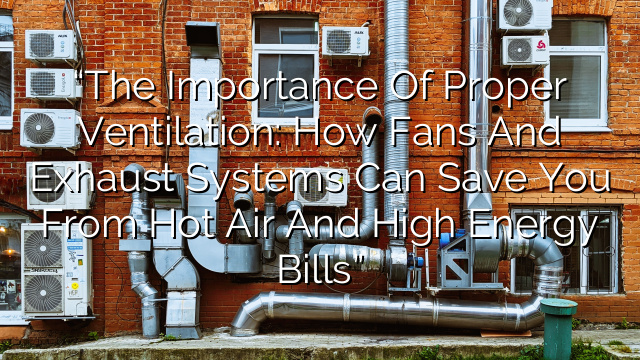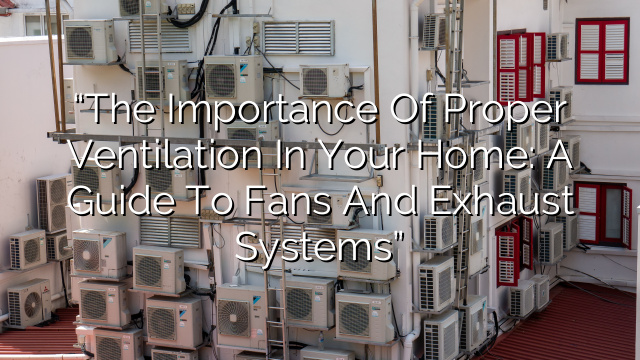Fans & Ventilation: Choosing the Right Voltage for Your Home Ventilation
When it comes to home ventilation, one of the most important factors to consider is the voltage of your exhaust fans. The voltage of a fan determines its power output and determines whether it will meet the needs of your home. In this article, we will explore the differences between 120 Volts and 240 Volts fans and help you choose the right voltage for your home ventilation needs.
Understanding Voltage: 120 Volts vs. 240 Volts
Voltage is a measure of electric potential energy per unit charge. In simpler terms, it is the force that drives electrical current through a circuit. In the case of home ventilation fans, voltage determines the power of the fan and the amount of air it can move. The higher the voltage, the more powerful the fan.
Most homes in North America are equipped with a standard electrical system that operates at 120 Volts. This voltage is suitable for most common household appliances and is the default voltage for exhaust fans and ventilation systems in residential settings. However, in some cases, a more powerful fan may be required, and that’s where 240 Volts comes into play.
The Advantages of 120 Volts Fans
120 Volts fans are the most common type of exhaust fans used in residential settings. They are designed to provide adequate ventilation for most homes and are suitable for a wide range of applications. Here are some advantages of choosing a 120 Volts fan for your home:
- Compatibility: 120 Volts fans are compatible with standard residential electrical systems, making them easy to install and replace. They can be plugged into a regular electrical outlet without the need for any special wiring.
- Availability: Since 120 Volts fans are the most common type, they are widely available and come in various sizes, styles, and power levels to meet different ventilation needs.
- Cost: 120 Volts fans are generally more affordable than 240 Volts fans. Their lower power output and ease of installation make them a cost-effective choice for most homeowners.
- Ease of Use: 120 Volts fans are designed to be user-friendly. They often come with adjustable speed settings and simple controls, making it easy to regulate the airflow and maintain proper ventilation in your home.
The Power of 240 Volts Fans
In some cases, a more powerful fan may be necessary to provide sufficient ventilation for a specific area of your home. This is where 240 Volts fans come into play. Here are some advantages of choosing a 240 Volts fan:
- Increased Airflow: Due to their higher voltage, 240 Volts fans can move more air than 120 Volts fans. This makes them suitable for larger spaces or areas that require higher air exchange rates, such as workshops, garages, or areas with high humidity levels.
- Ability to Handle Heavy Loads: If you are planning to connect multiple fans or other electrical devices to the same circuit, a 240 Volts fan may be a better choice. The higher voltage allows for increased power capacity, reducing the risk of overload or electrical failures.
- Longer Lifespan: Higher voltage fans are often built with more robust components and can withstand heavy usage over extended periods. This can result in a longer lifespan and reduce the need for frequent replacements.
- High-Performance Options: For those who require top-of-the-line ventilation, 240 Volts fans offer high-performance options with advanced features such as variable speed controls, timers, and automatic shut-off functions.
Choosing the Right Voltage for Your Home Ventilation
When deciding between 120 Volts and 240 Volts fans, consider the specific needs and requirements of your home. Ask yourself the following questions:
- What is the size of the area you need to ventilate?
- If you are ventilating a small bathroom or a small kitchen, a 120 Volts fan should be sufficient. However, if you are ventilating a large workshop or an open-concept living space, a more powerful 240 Volts fan may be necessary.
- What is the purpose of the ventilation?
- If you are primarily concerned with removing odors and moisture from your home, a 120 Volts fan should be adequate. However, if you require higher air exchange rates for activities such as painting or woodworking, a 240 Volts fan may be more suitable.
- Do you have the necessary electrical infrastructure?
- 240 Volts fans require a dedicated 240 Volts circuit and special wiring. If your home does not have this infrastructure in place, installing a 240 Volts fan may require additional electrical work and should be done by a licensed electrician.
- What is your budget?
- 240 Volts fans tend to be more expensive than their 120 Volts counterparts. Consider your budget and the specific needs of your home before making a decision.
Keep in mind that while choosing the appropriate voltage is important, proper installation and regular maintenance are equally crucial. Selecting the right fan based on voltage alone will not guarantee optimal ventilation if the fan is not installed correctly or if it is not well-maintained. Hire a professional if you are unsure about the installation process, and follow the manufacturer’s recommendations for maintenance and cleaning.
Frequently Asked Questions (FAQ)
- Can I install a 240 Volts fan in a home with a 120 Volts electrical system?
- No, installing a 240 Volts fan requires a dedicated 240 Volts circuit and special wiring. If your home is not wired for 240 Volts, it would require significant electrical work to accommodate a 240 Volts fan.
- Are 240 Volts fans louder than 120 Volts fans?
- The noise level of a fan depends on several factors, such as its design, construction, and motor quality. Voltage alone does not determine the noise level. When comparing fans, consider the decibel (dB) rating provided by the manufacturer.
- Can I use a 240 Volts fan in a bathroom?
- Yes, you can use a 240 Volts fan in a bathroom. However, it is important to ensure that the fan is rated for use in wet environments and that it is installed in compliance with local building codes and safety regulations.
- Can I use a 120 Volts fan in a workshop or garage?
- Yes, you can use a 120 Volts fan in a workshop or garage. However, if you require higher airflow or a more powerful fan, a 240 Volts fan may be a better option.
- Can I install a 240 Volts fan myself?
- Installing a 240 Volts fan requires specialized electrical knowledge and experience. It is recommended to hire a licensed electrician to ensure proper installation and compliance with local electrical codes and safety standards.
- Is it possible to convert a 120 Volts fan to a 240 Volts fan?
- No, it is not possible to convert a 120 Volts fan to a 240 Volts fan. The voltage requirements are determined by the fan’s internal components, and altering the voltage could damage the fan or pose a safety risk.
Choosing the right voltage for your home ventilation is essential for maintaining good indoor air quality and promoting a healthy living environment. Consider these factors, assess your needs, and consult with a professional if you are unsure about the electrical requirements or installation process. With the right fan and proper installation, you can enjoy clean and fresh air in your home for years to come.














